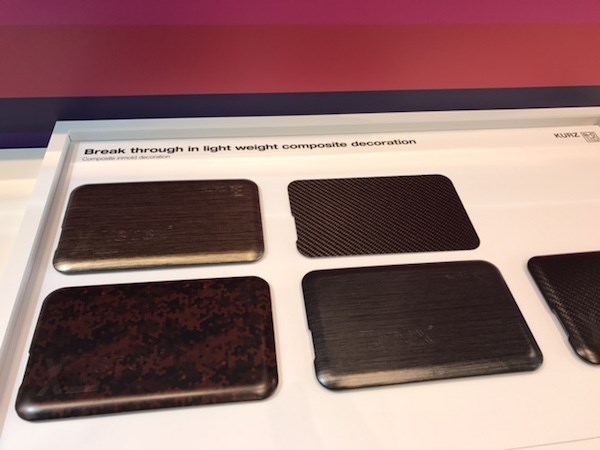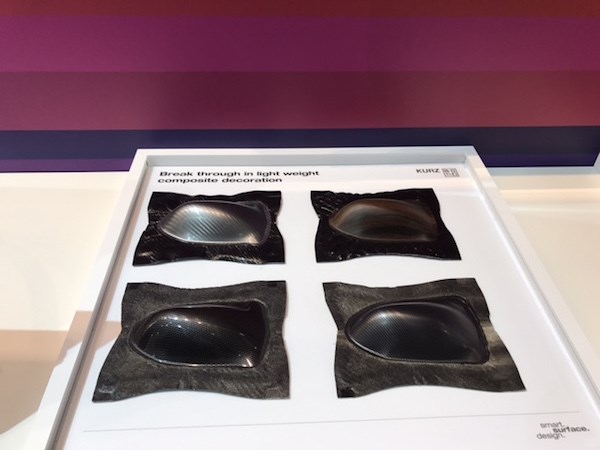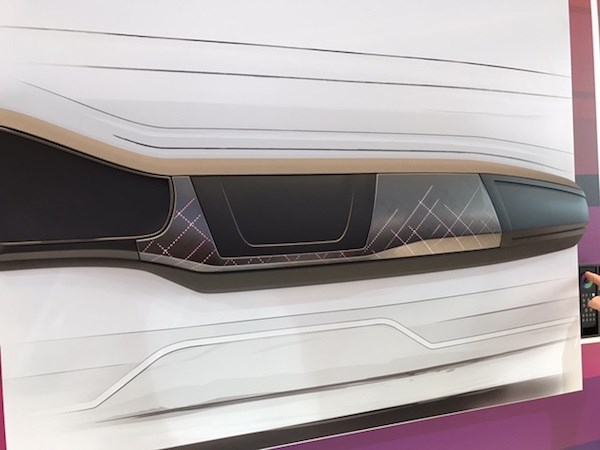Kurz, Engel and Lanxess Team for Decorated, Overmolded Continuous Fiber Sheet
A process to decorate a hybrid composite/thermoplastic part with a decorative film in one mold was among several new decorating technologies exhibited at K 2016 by The Kurz Group.
A process to decorate a hybrid composite/thermoplastic part with a decorative film in one mold was among several new decorating technologies exhibited at K 2016 by The Kurz Group.
Kurz Transfer Products LP in collaboration with LANXESS Corporation Bond Laminates and Engel Machinery, Inc. have developed a process that enables a plastic composite component to also be decorated in the same processing step.

The Tepex continuous-fiber-reinforced thermoplastic semi-finished composite from Bond Laminates is formed and overmolded with plastic in a vertical press and then decorated in the same shot with a film running reel to reel through the tool cavity. Kurz also developed a new IMD coating system to suit the process: its lacquer package bonds permanently to the materials of the composite component.
• IPD-Skin process (Individualized Post Decoration) is a new process developed by Kurz in collaboration with Niebling, which makes the new IPD-Skin machine. The process involves permanently bonding a thin decorative layer to a pre-finished part. This is heated and then moved to a vacuum forming/air pressure segment where the part is fully decorated. It can be used to decorate highly three-dimensional parts and undercuts and tactile surfaced with pronounced structures can also be implemented.

• Kurz also showed new design options for automotive lighting. Included are full-surface backlighting of carbon, wood, metal or colored designs. When illumination is activated, the structures of the base designs are maintained or presented in a modified form, and completely different colors and material effects are also created.

Partially backlit designs are also possible. During daylight, you see a single- or multi-colored solid surface; when backlit, both opaque and translucent elements become visible, with various levels of transparency possible.
• Kurz also demonstrated its ability to implement dead front effects and integrate touch and gesture functions. Using Kurz's own sensor technology based on the technology of its subsidiary PolyTC, plastic parts can be equipped with a sensor function that if desired can be non-visible when inactive. In daylight, you see a solid, opaque decorative surface; on touching, approaching, or gesturing, a light source is activated and a control panel becomes visible.
Related Content
-
ICIS Launches: Ask ICIS Generative AI Commodities Assistant
Said to be the first of its kind, this AI assistant will enhance access to ICIS’ intelligence and insights for the energy and chemical markets.
-
Soft Prices for Volume Resins
While PP and PE prices may be bottoming out, a downward trajectory was likely for all other volume resins, including engineering types.
-
General Polymers Thermoplastics to Further Expand Distribution Business
NPE2024: Following the company’s recent partnership buyout, new North American geographic territories are in its sight.















